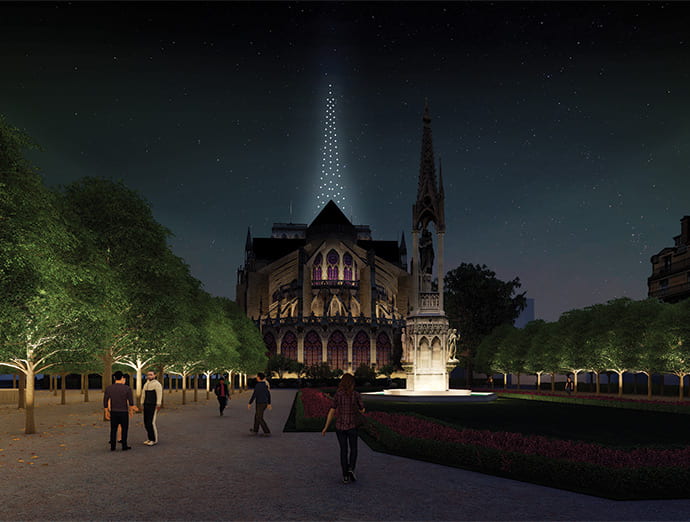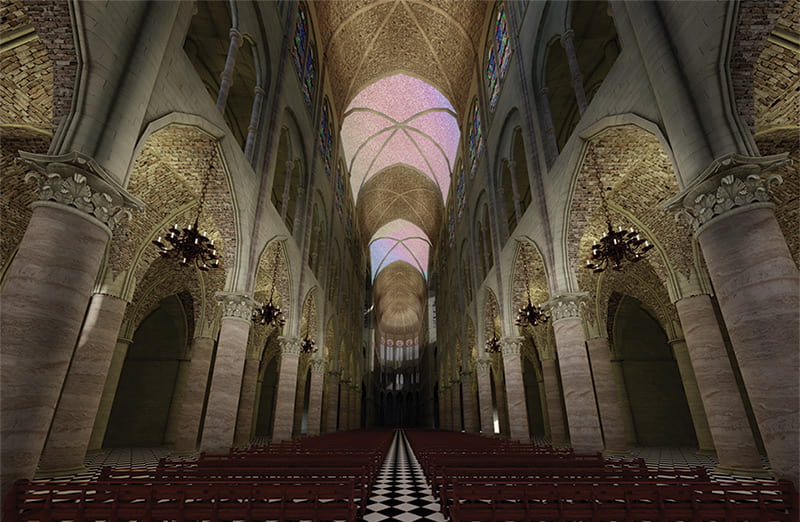Class Notes: A Proposal for Notre Dame: Illuminating Ascension
By Michael Fuhrman, Susan Tucker and Grace Gill
Renderings by Urbano Soto
Birthed in the airy 12th-century choir at Paris’ royal basilica, Saint-Denis, the Gothic style opened dark churches to soaring space, expanses of stained glass and jeweled light. France’s Capetian kings used the new style to extend their power, and Gothic caught on — in cathedrals, campuses, government buildings and private homes across Europe and into the United States, where it has persisted most notably in collegiate Gothic buildings like our own Gearhart Hall. In the Spring 2020 Signature Seminar, Gothic, led by architecture professor Kim Sexton and Dean Lynda Coon, students traced Gothic from its architectural origins in France through its infiltration into art, literature and popular culture. Reading period sources helped them absorb Gothic’s association with the sublime, royal power, the perverse and the sinister. For the final project, students developed and presented proposals for rebuilding Paris’ iconic Notre-Dame cathedral. Proposals ranged from a rooftop interpretive museum to a greenhouse pyramid sheltering a patriotic tricolor garden, and explored new construction techniques such as 3-D printing. The winning team, which included Michael Fuhrman, Susan Tucker and Grace Gill, put a 21st-century spin on Gothic light and surveillance; read their proposal and imagine the possibilities. Honors architecture student Urbano Soto produced the renderings.
The Gothic style of architecture has evolved and adapted through almost nine centuries of history to become one of the most versatile and recognizable art forms. The importance of Gothic continues today as the world looks to reconstruct the fire-damaged Notre-Dame Cathedral in Paris. In the ideas presented here, color, light and ascension project Gothic spirit into the future. As noted by the patron Abbot Suger, “the dull mind rises to truth through that which is material. … And, in seeing this light, is resurrected from its former submersion.” This light can be experienced through Gothic buildings such as Sainte-Chapelle in Paris and, prior to its destruction by fire, the Crystal Palace in London. Gothic buildings were not without their critics in the 12th century. Alexander Neckham criticized the lavish new churches of his day, saying “towers are erected that threaten the stars … nature complains that she is surpassed by art.” The great legacy of the Gothic inspires our proposal for Notre-Dame. In our vision for Notre-Dame, modernizing color, light and robotic ascension can
be used to recreate the incredible and everlasting spirit of Gothic.
In its time, the Gothic style redefined the use of windows and light to change the shape of interior spaces. In order to mimic and enhance the light that comes through the stained-glass windows in Notre-Dame, the roof will be replaced with clear glass and LED lighting. Gothic cathedrals drew on the latest technologies (pointed arches, vaulted ceilings, flying buttresses), and that progressive spirit will continue with this modern light source. The benefit of LEDs is versatility. With this technology, the display can be altered to mimic the colors in the stained-glass windows, changed to reflect major holidays or turned off if the light becomes problematic at night for Parisians. In addition, the Gothic architectural style emphasized thinness and lightness of material, and these mediums will reinforce that idea. What is left of the ceiling will remain intact, and “empty” rib vaults will rise free through the air across the sections that collapsed in the fire. With this approach, the modern and the medieval will blend together to form a harmonious structure and play into the adaptive spirit of Gothic architecture.
Rather than rebuild the spire we have chosen to leave it absent from the regular day-time silhouette. However, the spire is the visual culmination of Notre-Dame specifically and an aspirational symbol in the history of Gothic. To play into the adaptive and dynamic nature of Gothic architecture, we have decided to deploy new drone technology to suggest the shadow of a spire through suspended light. Similar to the lighting of the Eiffel Tower, this visual spectacle would be performed potentially every night, or just one night a week. The utilization of drones in hand with the LED roof of the building opens up opportunities for religious or artistic expression; the opening ceremony of the 2018 Winter Olympics in Pyeongchang, South Korea, is a perfect example. Beyond the modern spectacle that drones provide, the technology also offers subtle commentary on the history of Gothic and monarchy, and the growing role of surveillance in modern times. In this way, the drones complete the narrative of Gothic’s ascension to the heavens and rule over the corporeal realm.
Throughout our seminar, Gothic architecture has been noted for its ability to adapt to the modern context and outlive the limitations of other styles. By using LED and drone technology, our proposal for Notre-Dame not only reshapes itself for the modern gaze but also harmonizes with the inventive spirit of its original Gothic architects.




